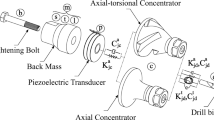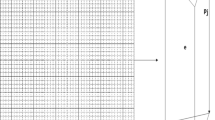Abstract
A lumped parameter vibro-impact model is proposed to describe the axial dynamics of a vibration-assisted drilling tool prototype, developed to improve the drilling efficiency in hard-rock drilling applications. The purpose of this work is twofold: to develop a new mathematical model that represents the axial dynamics of a vibration-assisted drilling tool, and to validate the proposed mathematical model with field data. The proposed model has seven degrees-of-freedom model with four impact surfaces. High-frequency field data, measured at multiple locations, are used to validate the mathematical model. The results show an overall good match between field data and model outputs, as the vibro-impact model is capable of capturing and reproducing the main dynamic behavior of the vibration-assisted drilling tool. Furthermore, the proposed model is able to reproduce complex dynamic behavior with little computational cost, due to the low number of degrees-of-freedom.













Similar content being viewed by others
References
Aguiar R, Weber H (2011) Mathematical modeling and experimental investigation of an embedded vibro-impact system. Nonlinear Dyn 65(3):317–334
Ajibose OK, Wiercigroch M, Pavlovskaia E, Akisanya AR (2010) Global and local dynamics of drifting oscillator for different contact force models. Int J Non-Linear Mech 45(9):850–858
Cao QJ, Wiercigroch M, Pavlovskaia E, Yang SP (2010) Bifurcations and the penetrating rate analysis of a model for percussive drilling. Acta Mechanica Sinica 26(3):467–475
Franca LFP, Weber HI (2004) Experimental and numerical study of a new resonance hammer drilling model with drift. Chaos Solitons Fractals 21(4):789–801
Gee R, Ramirez T, Barton SP, Souza J, Da Fonseca CE, Cote B, Valmorbida D et al. (2012) Reliable hammer motor smashes its way to speedy success in Brazil. In: IADC/SPE Drilling Conference and Exhibition. Society of Petroleum Engineers
Gilardi G, Sharf I (2002) Literature survey of contact dynamics modelling. Mech Mach Theory 37(10):1213–1239
Goldsmit W (1984) The theory and physical behavior of colliding solids (arnold, london, 1960); fg bridges, a. hatzes, and dnc lin. Nature (London) 309, 333
Herrington D, Barton S, Powell S et al. (2013) Step change technology amplifies vertical force applied to formation at the bit enhancing cutting efficiency. In: SPE Asia Pacific Oil and Gas Conference and Exhibition. Society of Petroleum Engineers
Herrington D, Barton SP, Cote B, Gaines MJ, Morrison R et al. (2012) Hammer motor breaks new ground in china. In: SPE Asia Pacific Oil and Gas Conference and Exhibition. Society of Petroleum Engineers
Hertz H, Jones DE, Schott GA (1896) Miscellaneous papers. Macmillan and Company, New York
Hunt K, Crossley F (1975) Coefficient of restitution interpreted as damping in vibroimpact. J Appl Mech 42(2):440–445
Lagreca A, De Santana D, Suarez G, Rodriguez M, McInnes M et al (2002) Fluid percussion hammer field test in the alocthonous cretaceous block, eastern venezuela. In: Canadian International Petroleum Conference. Petroleum Society of Canada
Pavlovskaia E, Wiercigroch M (2003) Periodic solution finder for an impact oscillator with a drift. J Sound Vibr 267(4):893–911
Pavlovskaia E, Wiercigroch M, Grebogi C (2001) Modeling of an impact system with a drift. Phys Rev E 64(5):056224
Pavlovskaia E, Wiercigroch M, Woo KC, Rodger AA (2003) Modelling of ground moling dynamics by an impact oscillator with a frictional slider. Meccanica 38(1):85–97
Peterka F, Kotera T, Čipera S (2004) Explanation of appearance and characteristics of intermittency chaos of the impact oscillator. Chaos Solitons Fractals 19(5):1251–1259
Placido JCR, Lage ACV, Carvalho DJ, Hardie R, Wajid R et al. (2003) A new type of hydraulic hammer compatible with conventional drilling fluids. In: SPE Annual Technical Conference and Exhibition. Society of Petroleum Engineers
Powell SW, Herrington D, Botton B, Ivie BS et al. (2013) Fluid hammer increases pdc performance through axial and torsional energy at the bit. In: SPE Annual Technical Conference and Exhibition. Society of Petroleum Engineers
Riley W, Sturges L (1996) Engineering mechanics dynamics. Wiley, New York
Robert WF, Alan MT, Philip JP (1998) Introduction to fluid mechanics. Wiley, New York, p 38
Schlumberger: Hammer bit percussion drilling - operating instructions. Technical Report E6.00101, Smith Bits - A Schlumberger Company (2012)
Staysko R, Francis B, Cote B et al (2011) Fluid hammer drives down well costs. In: SPE/IADC Drilling Conference and Exhibition. Society of Petroleum Engineers
Tibbitts GA, Long RC, Miller BE, Arnis J, Black AD et al. (2002) World’s first benchmarking of drilling mud hammer performance at depth conditions. In: IADC/SPE Drilling Conference. Society of Petroleum Engineers
Acknowledgements
The authors would like to acknowledge Schlumberger management for authorizing the publication of this article. The third author would like to acknowledge that this investigation was financed in part by the Brazilian agencies: Coordenação de Aperfeiçoamento de Pessoal de Nível Superior (CAPES)—Finance code 001—Grant PROEX 803/2018, Conselho Nacional de Desenvolvimento Cientìfico e Tecnológico (CNPQ)—Finance code 400933/2016-0, and Fundação Carlos Chagas Filho de Amparo à Pesquisa do Estado do Rio de Janeiro (FAPERJ)—Finance code E-26/201.572/2014.
Author information
Authors and Affiliations
Corresponding author
Additional information
Technical Editor: Wallace Moreira Bessa.
Publisher's Note
Springer Nature remains neutral with regard to jurisdictional claims in published maps and institutional affiliations.
Rights and permissions
About this article
Cite this article
Aguiar, R.R., d’Almeida, E.F.V. & Ritto, T.G. Vibro-impact model and validation of the axial dynamics of a vibration-assisted drilling tool. J Braz. Soc. Mech. Sci. Eng. 42, 598 (2020). https://doi.org/10.1007/s40430-020-02680-0
Received:
Accepted:
Published:
DOI: https://doi.org/10.1007/s40430-020-02680-0




